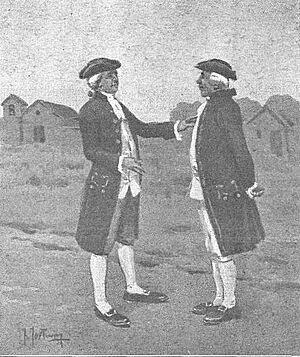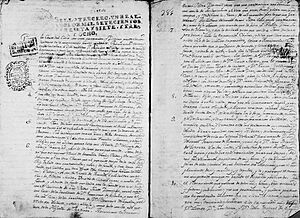Juan Miguel de Esparza facts for kids
Quick facts for kids
Juan Miguel de Esparza
|
|
|---|---|
| Mayor of Buenos Aires | |
| In office 1764–1765 |
|
| Monarch | Charles III of Spain |
| Preceded by | Joseph Blás de Gainza |
| Succeeded by | Eugenio Lerdo de Tejada |
| Vice-Mayor of Buenos Aires | |
| In office 1748–1749 |
|
| Monarch | Ferdinand VI of Spain |
| Preceded by | Francisco Rodríguez de Vida |
| Succeeded by | Pedro Contreras |
| Personal details | |
| Born |
Juan Miguel de Esparza Cabral de Melo y Morales
1712 Buenos Aires, Argentina |
| Died | 1766 Buenos Aires, Argentina |
| Resting place | Santo Domingo Convent |
| Spouses | María Josefa González de Alderete María Eugenia Sánchez Gallanes |
| Children | Camila de Esparza Catalina Bernarda de Esparza |
| Relatives | Francisco Antonio de Esparza (uncle) Juan José Rocha Esparza (grandson) Juan José Rocha Durán (great-grandson) Isidro Quesada Rocha (great-grandson) Isidro Félix Quesada (relative in law) Pedro Morales y Mercado (ancestor) Francisco Pérez de Burgos (ancestor) |
| Occupation | government politician militia law merchant |
| Profession | jurist accountant military man |
| Signature | |
| Military service | |
| Allegiance | |
| Branch/service | Spanish Army |
| Years of service | 1732-1766 |
| Rank | Captain |
| Unit | Fuerte de Buenos Aires |
| Commands | Milicias Provinciales de Buenos Aires |
Juan Miguel de Esparza (1712–1766) was an important Spanish military officer, merchant, and politician. He lived in the Viceroyalty of Peru, which was a large Spanish territory in South America. He held important positions like alcalde (mayor) and regidor (council member).
Juan Miguel de Esparza also took part in many military trips. These trips aimed to control the movement of Indigenous groups in the Buenos Aires area. He also worked as a lawyer and treasurer. He was an "Alférez real," which meant he carried the Royal Standard (a special flag) during important ceremonies.
He served as the "Procurador General" (Attorney General) of Buenos Aires in 1737 and 1754. In this role, he helped oversee and manage trade and government matters.
Contents
Life and Public Service

Juan Miguel de Esparza was born in Buenos Aires in 1712. His parents were Miguel Gerónimo de Esparza and Antonia Cabral de Melo. His family was well-known and respected in the city.
He went to school at the Colegio Nacional de Monserrat. Later, he studied law at the University of Saint Francis Xavier. His first public job was in 1737 as the Procurador General of Buenos Aires. He was also in charge of collecting money for the King of Spain. In 1738, he helped with the city's census, counting the people living there.
He traveled to Spain several times and lived in Cádiz for a while. There, he worked as a merchant, buying and selling goods. He returned to Buenos Aires around 1743. He continued his work in trade and government. In 1749, he reported illegal trade of animal hides by foreign ships near the Río de la Plata.
Roles in City Government
Juan Miguel de Esparza served as the vice-mayor of Buenos Aires in 1748. He was then elected mayor of the city in 1764. As mayor, he oversaw the building of a new tower for the city's Cabildo (the local government building). This tower was finished in 1765 and had an expensive clock brought from Cádiz, Spain.
He also worked as a "regidor" (council member) for the Ayuntamiento (city council). He was also the treasurer for the "Reales Cajas de la Real Audiencia de Buenos Aires," which managed royal funds. He was involved in discussions about the conflict between Spain and Portugal. This conflict, known as the Spanish–Portuguese War, was about who controlled Colonia del Sacramento.
Ceremonial Duties and Legal Work
Esparza played a big part in ceremonies for important people. In 1747, he attended the funeral services in Buenos Aires for King Philip V of Spain. He carried the Royal Standard during celebrations for the new King, Ferdinand VI of Spain. During these events, he was escorted by a group of soldiers called Dragons, who carried their swords.
In 1754, Juan Miguel de Esparza acted as a lawyer for several people who were owed money by a merchant named Francisco de Escalada. One of these people was Patrick Lynch, a famous Irish merchant in Buenos Aires. Esparza also provided legal help to people who couldn't afford it. This included a man named Felix, who worked as an executioner for the city.
In 1763, Juan Miguel de Esparza appointed Jerónimo de Angulo as his agent. Jerónimo de Angulo was a knight of the Order of Santiago. He handled Esparza's legal matters in the Viceroyalty of Peru.
Military Service
Juan Miguel de Esparza served for many years in the Milicias Provinciales de Buenos Aires, part of the Spanish Army. He actively participated in military actions against the Indigenous Pampas people. These groups sometimes attacked Spanish settlements near Lujan. In 1752, he joined expeditions against the Calelián tribes. He served in a militia unit called "La Valerosa," which was part of the Blandengues of the Frontier. He served under Captain José de Zarate.
Community Involvement
Esparza helped establish several charity organizations in the city. One of these was the Hermandad de la Caridad (Brotherhood of Charity). This was a religious group that helped people in colonial Buenos Aires. Today, a street in the Balvanera neighborhood is named Esparza. It honors several members of the Esparza family, including Juan Miguel.
Family Life
Juan Miguel de Esparza was baptized on January 30, 1712. This took place at the Cathedral of Buenos Aires. His godparents were Miguel de Riglos and Josefa Rosa Alvarado.
He married his cousin, María Eugenia Sánchez. She was the daughter of Francisco Sánchez and Sebastiana Zenarro. María Eugenia was a noble lady and part of the Third Order of Saint Francis. Juan Miguel and María Eugenia had many children. Their son, Mariano Marcos Esparza, had Francisco Álvarez Campana as his godfather. Their daughter, María Ana de Esparza, had Francisco de Cabrera and Antonia Saavedra as her godparents.
His wife, María Eugenia Sánchez Gallanos, was born in Buenos Aires in 1730. She passed away on March 3, 1817, and was buried in the Santo Domingo convent. In her will, she stated that she owned a house in the Santo Domingo neighborhood. This house was near the homes of the Warnes ladies and Mariano Olier, a family friend. Her mother's family was connected to Juan de Zenarro, from Pasaia, and Inés Esparza Rodríguez, from Buenos Aires.
Not much information is known about his father-in-law, Captain Francisco Sánchez Gallano. He was a Spanish noble and also part of the Third Order of Saint Francis.
All of Juan Miguel de Esparza's sons died in Buenos Aires during the colonial period. His daughter, Camila de Esparza, married Juan José de Rocha. They are direct ancestors of important figures like Emilio Castro Rocha and Dardo Rocha, who were governors of Buenos Aires Province. His other daughter, Bernarda Catalina de Esparza, married Juan de Canaveris. Juan de Canaveris was present at the "Open Cabildo" meeting during the May Revolution. Most of Juan Miguel de Esparza's descendants come through the Canaveris Esparza marriage. This family line is connected to many of Argentina's main families.
Juan Miguel de Esparza was a distant relative of important Spanish historical figures. These included kings and queens of Castile and Navarre. His great-uncle, Manuel Cabral de Alpoim, received a certificate of nobility in 1612. Through his daughters, Juan Miguel's family line connected to other well-known families like the Porcel de Peralta, Ramos Mexía, Castro Castillo, Pueyrredón, and O'Dogan families. He also had a connection to Brigadier Estanislao López.
His father's family came from Navarra, Spain. His mother's family line came from Ronda, in the Province of Málaga, Spain.
See also
 In Spanish: Juan Miguel de Esparza para niños
In Spanish: Juan Miguel de Esparza para niños


